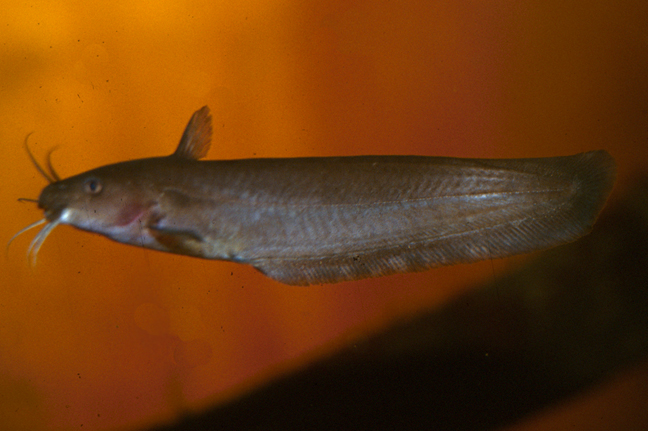Dalhousie Catfish, Neosilurus gloveri Allen & Feinberg 1998

Dalhousie Catfish, Neosilurus gloveri. Source: Michael Hammer. License: all rights reserved
A dark chocolate brown to greyish eel-tailed catfish with a paler belly and fins. This is the smallest species in the family Plotosidae, and is only found in the warm artesian pools in Dalhousie Mound Springs Complex, Witjira National Park, in the arid zone of northern South Australia.
Dalhousie Catfish, Neosilurus gloveri Allen & Feinberg 1998
More Info
|
Distribution |
Occurs in a small subset of mound springs in the Dalhousie Mound Springs Complex, Witjira National Park, in the arid zone of northern South Australia. Although individual springs are isolated, all springs in the complex have a common groundwater source - the Great Artesian Basin. When it was described in 1998, the species was only known from the Main Spring at Dalhousie Springs and Nilpinna Spring in the northern part of South Australia. The species was abundant in the spring in water temperatures between 33.5-38.3 deg C. The Dalhousie Catfish is nocturnal and swims near the bottom of these warm, artesian spring-fed pools and their outlet streams. |
|
Features |
Dorsal fin I, 4-5; Caudal/Dorsal/Anal rays 53; Pectoral fin I, 7-9; Pelvic fin 9-11; Gill rakers 14-16; Vertebrae 38-42; Branchiostegal rays 7-8.
Body elongate, tapering posteriorly; body depth 14-19 % SL; head moderately flattened dorsoventrally; head length 20-25% SL; dorsal profile of head nearly straight; snout pointed in lateral view, snout length 35-42 % HL; mouth subterminal; lips fleshy but relatively thin; anterior nostril tubular, on upper lip; posterior nostril narrow slit behind nasal barbel; eyes relatively small, eye diameter 15-21 % HL; nasal barbel reaching slightly beyond level of eye, nasal barbel length 40-60% HL; maxillary and outer mental barbels reaching to about edge of preoperculum; inner mental barbel slightly shorter; slender conical teeth in several rows on upper and lower jaws, patch of larger conical teeth on palate; branchiostegal rays 6-8. First dorsal fin relatively short, its tip pointed, originating in front of level of pelvic fins; pectoral fins inserted just behind opercular margin, tips rounded; caudodorsal fin originating far back towards end of body; base of caudodorsal fin 18-25% SL. |
|
Size |
12 cm TL. |
|
Colour |
Dark chocolate brown to greyish above, lighter below and on fins. |
|
Feeding |
Omnivore - nocturnally active fishes that feed on active aquatic invertebrates (e.g. ostracods), terrestrial insects, small fishes such as hardyheads, and benthic prey such as gastropods molluscs, along with some plant material. |
|
Biology |
The sexes are separate and fertilisation is external. Females reach sexual maturity at 44 mm SL, and spawn small (~ 1mm), non-adhesive eggs that are likely to be scattered over the substrate. Glover (1989) reported that a 72 mm TL female contained 136 eggs, and a 120 mm TL female carried 1197 eggs. It is not known if spawning is seasonal or occurs all year round. |
|
Fisheries |
Of no interest to fisheries. |
|
Conservation |
IUCN Red List Status: Critically Endangered Environment Protection and Biodiversity Conservation Act 1999 (EPBC Act): Critically Endangered |
|
Remarks |
Tolerates salinity to 10 p.p.t. and temperatures between 16° and 44°C, but usually remains in water between 30° and 38°C. |
|
Similar Species |
Differs from other species in its very small size and some meristic features. |
|
Etymology |
Neosilurus is from the Greek neos meaning "new", and silouros meaning "catfish". The species is named after the late John Glover, former Curator of Fishes at the South Australian Museum. |
|
Species Citation |
Neosilurus gloveri Allen & Feinberg 1998, aqua, Journal of Ichthyology and Aquatic Biology 3(1): 13, fig.1. Type locality: Main Spring, Dalhousie Springs, South Australia, about 26°25'S, 135°30'E. |
|
Author |
Gomon, M.F. & Bray, D.J. 2024 |
|
Resources |
Dalhousie Catfish, Neosilurus gloveri Allen & Feinberg 1998
References
Allen, G.R. 1989. Freshwater Fishes of Australia. Neptune, New Jersey : T.F.H. Publications 240 pp., 63 pls. (as Neosilurus sp. A)
Allen, G.R. & Feinberg, M.N. 1998. Descriptions of a new genus and four new species of freshwater catfishes (Plotosidae) from Australia. Aqua, Journal of Ichthyology and Aquatic Biology 3(1): 9-18 figs 1-6
Allen, G.R., Midgley, S.H. & Allen, M. 2002. Field Guide to the Freshwater Fishes of Australia. Perth : Western Australian Museum 394 pp.
Glover, C. J. M. 1989. Fishes, pp 89-112 in Zeidler, W. & Ponder, W.F. (eds). Natural History of Dalhousie Springs. Adelaide : South Australian Museum.
Glover, C. J. M., & Sim, T. C. 1978. Studies on central Australian fishes: a progress report. South Australian Naturalist 52(3): 35-44.
Hammer M. 2002. Natural habitat, spawning and rearing of the Dalhousie Catfish. Fishes of Sahul 16: 820–827.
Hammer, M.P., Adams, M. & Foster, R. 2012. Update to the catalogue of South Australian freshwater fishes (Petromyzontida & Actinopterygii). Zootaxa 3593: 59-74. https://doi.org/10.11646/zootaxa.3593.1.3
Hammer, M.P. & Walker, K.F. 2004. A catalogue of South Australian freshwater fishes, including new records, range extensions and translocations. Transactions of the Royal Society of South Australia 128(2): 85-97 See ref at BHL
Hammer, M., S. Wedderburn & J. van Weenen. 2009. Action Plan for South Australian Freshwater Fishes. Native Fish Australia (SA) Inc., Adelaide: 1-24
Kerezsy, A. 2020. Fishes of Australia’s Great Artesian Basin Springs – An Overview. Proceedings of The Royal Society of Queensland 126: 117-127 See ref online
Kodric-Brown, A. & Brown, J. H. 1993. Highly structured fish communities in Australian desert springs. Ecology 74(6): 1847-1855. https://doi.org/10.2307/1939942
Unmack, P.J. 2001. Biogeography of Australian freshwater fishes. Journal of Biogeography 28: 1053-1089 https://doi.org/10.1046/j.1365-2699.2001.00615.x
Wager, R. & Unmack, P.J. 2000. Fishes of the Lake Eyre Catchment of Central Australia. Brisbane : Department of Primary Industries and Queensland Fisheries Service 88 pp.
Whiterod, N., Hammer, M., Unmack, P., Mathwin, R. & Gotch, T. 2019. Neosilurus gloveri. The IUCN Red List of Threatened Species 2019: e.T122900298A123382046. https://dx.doi.org/10.2305/IUCN.UK.2019-3.RLTS.T122900298A123382046.en. Accessed on 15 August 2024.

